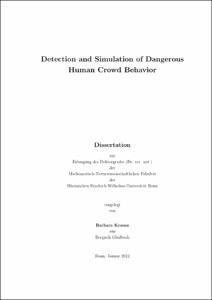Krausz, Barbara: Detection and Simulation of Dangerous Human Crowd Behavior. - Bonn, 2013. - Dissertation, Rheinische Friedrich-Wilhelms-Universität Bonn.
Online-Ausgabe in bonndoc: https://nbn-resolving.org/urn:nbn:de:hbz:5n-30675
Online-Ausgabe in bonndoc: https://nbn-resolving.org/urn:nbn:de:hbz:5n-30675
@phdthesis{handle:20.500.11811/5418,
urn: https://nbn-resolving.org/urn:nbn:de:hbz:5n-30675,
author = {{Barbara Krausz}},
title = {Detection and Simulation of Dangerous Human Crowd Behavior},
school = {Rheinische Friedrich-Wilhelms-Universität Bonn},
year = 2013,
month = jan,
note = {Tragically, gatherings of large human crowds quite often end in crowd disasters such as the recent catastrophe at the Loveparade 2010. In the past, research on pedestrian and crowd dynamics focused on simulation of pedestrian motion. As of yet, however, there does not exist any automatic system which can detect hazardous situations in crowds, thus helping to prevent these tragic incidents.
In the thesis at hand, we analyze pedestrian behavior in large crowds and observe characteristic motion patterns. Based on our findings, we present a computer vision system that detects unusual events and critical situations from video streams and thus alarms security personnel in order to take necessary actions. We evaluate the system’s performance on synthetic, experimental as well as on real-world data. In particular, we show its effectiveness on the surveillance videos recorded at the Loveparade crowd stampede. Since our method is based on optical flow computations, it meets two crucial prerequisites in video surveillance: Firstly, it works in real-time and, secondly, the privacy of the people being monitored is preserved.
In addition to that, we integrate the observed motion patterns into models for simulating pedestrian motion and show that the proposed simulation model produces realistic trajectories. We employ this model to simulate large human crowds and use techniques from computer graphics to render synthetic videos for further evaluation of our automatic video surveillance system.},
url = {https://hdl.handle.net/20.500.11811/5418}
}
urn: https://nbn-resolving.org/urn:nbn:de:hbz:5n-30675,
author = {{Barbara Krausz}},
title = {Detection and Simulation of Dangerous Human Crowd Behavior},
school = {Rheinische Friedrich-Wilhelms-Universität Bonn},
year = 2013,
month = jan,
note = {Tragically, gatherings of large human crowds quite often end in crowd disasters such as the recent catastrophe at the Loveparade 2010. In the past, research on pedestrian and crowd dynamics focused on simulation of pedestrian motion. As of yet, however, there does not exist any automatic system which can detect hazardous situations in crowds, thus helping to prevent these tragic incidents.
In the thesis at hand, we analyze pedestrian behavior in large crowds and observe characteristic motion patterns. Based on our findings, we present a computer vision system that detects unusual events and critical situations from video streams and thus alarms security personnel in order to take necessary actions. We evaluate the system’s performance on synthetic, experimental as well as on real-world data. In particular, we show its effectiveness on the surveillance videos recorded at the Loveparade crowd stampede. Since our method is based on optical flow computations, it meets two crucial prerequisites in video surveillance: Firstly, it works in real-time and, secondly, the privacy of the people being monitored is preserved.
In addition to that, we integrate the observed motion patterns into models for simulating pedestrian motion and show that the proposed simulation model produces realistic trajectories. We employ this model to simulate large human crowds and use techniques from computer graphics to render synthetic videos for further evaluation of our automatic video surveillance system.},
url = {https://hdl.handle.net/20.500.11811/5418}
}






